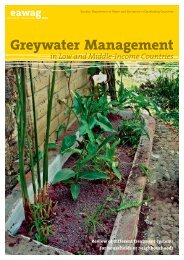Household Water Treatment and Safe Storage Factsheet: Source ...
Household Water Treatment and Safe Storage Factsheet: Source ...
Household Water Treatment and Safe Storage Factsheet: Source ...
You also want an ePaper? Increase the reach of your titles
YUMPU automatically turns print PDFs into web optimized ePapers that Google loves.
<strong>Household</strong> <strong>Water</strong> <strong>Treatment</strong> <strong>and</strong> <strong>Safe</strong> <strong>Storage</strong><br />
Fact Sheet: Chlorine (NaDCC Tablets)<br />
The <strong>Treatment</strong> Process<br />
Potential <strong>Treatment</strong> Capacity<br />
Very Effective For: Somewhat Effective For: Not Effective For:<br />
Bacteria<br />
Viruses<br />
Some protozoa<br />
Helminths<br />
Cryptosporidium parvum<br />
Toxoplasma oocysts<br />
Turbidity<br />
Chemicals<br />
Taste, odour, colour<br />
What is NADCC?<br />
Chlorine began to be widely used as a<br />
disinfectant in the early 1900’s. It<br />
revolutionized drinking water treatment <strong>and</strong><br />
dramatically reduced the incidence of<br />
waterborne diseases. Chlorine remains the<br />
most widely used chemical for water<br />
disinfection in the United States.<br />
NaDCC also known as sodium<br />
dichloroisocyanurate or sodium troclosene,<br />
is one form of chlorine used for disinfection.<br />
It is often used to treat water in<br />
emergencies, <strong>and</strong> is now widely available for<br />
household water treatment.<br />
Tablets are available from Medentech Ltd.<br />
with different NaDCC contents (e.g. 2 mg to<br />
5 g) to treat different volumes of water (e.g.<br />
1 to 2,500 litres) at a time. They are usually<br />
effervescent, allowing the smaller tablets to<br />
dissolve in less than 1 minute.<br />
How Does It Remove Contamination?<br />
When added to water, NaDCC releases<br />
hydrochlorous acid which reacts through<br />
oxidization with microorganisms <strong>and</strong> kills<br />
them.<br />
Three things can happen when chlorine is<br />
added to water:<br />
1. Some chlorine reacts through<br />
oxidization with organic matter <strong>and</strong> the<br />
pathogens in the water <strong>and</strong> kills them.<br />
This portion is called consumed<br />
chlorine.<br />
2. Some chlorine reacts with other organic<br />
matter, ammonia <strong>and</strong> iron <strong>and</strong> forms<br />
new chlorine compounds. This is called<br />
combined chlorine.<br />
3. Excess chlorine that is not consumed or<br />
combined remains in the water. This<br />
portion is called free residual chlorine<br />
(FRC). The FRC is the most effective<br />
form of chlorine for disinfection<br />
(particularly for viruses) <strong>and</strong> helps<br />
prevent recontamination of the treated<br />
water.
















